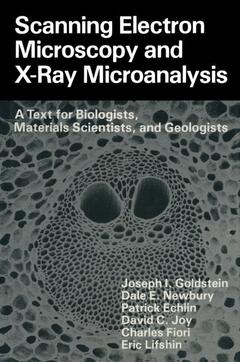Scanning Electron Microscopy and X-Ray Microanalysis, 1981 A Text for Biologists, Materials Scientists, and Geologists
Langue : Anglais
Auteurs : Goldstein Joseph, Newbury Dale E., Echlin Patrick, Joy David C., Fiori Charles, Lifshin Eric

This book has evolved by processes of selection and expansion from its predecessor, Practical Scanning Electron Microscopy (PSEM), published by Plenum Press in 1975. The interaction of the authors with students at the Short Course on Scanning Electron Microscopy and X-Ray Microanalysis held annually at Lehigh University has helped greatly in developing this textbook. The material has been chosen to provide a student with a general introduction to the techniques of scanning electron microscopy and x-ray microanalysis suitable for application in such fields as biology, geology, solid state physics, and materials science. Following the format of PSEM, this book gives the student a basic knowledge of (1) the user-controlled functions of the electron optics of the scanning electron microscope and electron microprobe, (2) the characteristics of electron-beam-sample inter actions, (3) image formation and interpretation, (4) x-ray spectrometry, and (5) quantitative x-ray microanalysis. Each of these topics has been updated and in most cases expanded over the material presented in PSEM in order to give the reader sufficient coverage to understand these topics and apply the information in the laboratory. Throughout the text, we have attempted to emphasize practical aspects of the techniques, describing those instru ment parameters which the microscopist can and must manipulate to obtain optimum information from the specimen. Certain areas in particular have been expanded in response to their increasing importance in the SEM field. Thus energy-dispersive x-ray spectrometry, which has undergone a tremendous surge in growth, is treated in substantial detail.
1. Introduction.- 1.1. Evolution of the Scanning Electron Microscope.- 1.2. Evolution of the Electron Probe Microanalyzer.- 1.3. Outline of This Book.- 2. Electron Optics.- 2.1. Electron Guns.- 2.2. Electron Lenses.- 2.3. Electron Probe Diameter, dp, vs. Electron Probe Current i.- 3. Electron-Beam-Specimen Interactions.- 3.1. Introduction.- 3.2. Scattering.- 3.3. Interaction Volume.- 3.4. Backscattered Electrons.- 3.5. Signals from Inelastic Scattering.- 3.6. Summary.- 4. Image Formation in the Scanning Electron Microscope.- 4.1. Introduction.- 4.2. The Basic SEM Imaging Process.- 4.3. Stereomicroscopy.- 4.4. Detectors.- 4.5. The Roles of Specimen and Detector in Contrast Formation.- 4.6. Image Quality.- 4.7. Signal Processing for the Display of Contrast Information.- 5. X-Ray Spectral Measurement: WDS and EDS.- 5.1. Introduction.- 5.2. Wavelength-Dispersive Spectrometer.- 5.3. Energy-Dispersive X-Ray Spectrometer.- 5.4. Comparison of Wavelength-Dispersive Spectrometers with Energy-Dispersive Spectrometers.- Appendix: Initial Detector Setup and Testing.- 6. Qualitative X-Ray Analysis.- 6.1. Introduction.- 6.2. EDS Qualitative Analysis.- 6.3. WDS Qualitative Analysis.- 6.4. X-Ray Scanning.- 7. Quantitative X-Ray Microanalysis.- 7.1. Introduction.- 7.2. ZAF Technique.- 7.3. The Empirical Method.- 7.4. Quantitative Analysis with Nonnormal Electron Beam Incidence.- 7.5. Analysis of Particles and Rough Surfaces.- 7.6. Analysis of Thin Films and Foils.- 7.7. Quantitative Analysis of Biological Material.- Appendix A: Continuum Method.- Appendix B: Worked Examples of Quantitative Analysis of Biological Material.- Notation.- 8. Practical Techniques of X-Ray Analysis.- 8.1. General Considerations of Data Handling.- 8.2. Background Shape.- 8.3. Peak Overlap.- 8.4. Dead-Time Correction.- 8.5. Example of Quantitative Analysis.- 8.6. Precision and Sensitivity in X-Ray Analysis.- 8.7. Light Element Analysis.- 9. Materials Specimen Preparation for SEM and X-Ray Microanalysis.- 9.1. Metals and Ceramics.- 9.2. Particles and Fibers.- 9.3. Hydrous Materials.- 10. Coating Techniques for SEM and Microanalysis.- 10.1. Introduction.- 10.2. Thermal Evaporation.- 10.3. Sputter Coating.- 10.4. Specialized Coating Methods.- 10.5. Determination of Coating Thickness.- 11. Preparation of Biological Samples for Scanning Electron Microscopy.- 11.1. Introduction.- 11.2. Compromising the Microscope.- 11.3. Compromising the Specimen.- 12. Preparation of Biological Samples for X-Ray Microanalysis.- 12.1. Introduction.- 12.2. Ambient Temperature Preparative Procedures.- 12.3. Low-Temperature Preparative Procedures.- 12.4. Microincineration.- 13. Applications of the SEM and EPMA to Solid Samples and Biological Materials.- 13.1. Study of Aluminum-Iron Electrical Junctions.- 13.2. Study of Deformation in Situ in the Scanning Electron Microscope.- 13.3. Analysis of Phases in Raney Nickel Alloy.- 13.4. Quantitative Analysis of a New Mineral, Sinoite.- 13.5. Determination of the Equilibrium Phase Diagram for the Fe-Ni-C System.- 13.6. Study of Lunar Metal Particle 63344,1.- 13.7. Observation of Soft Plant Tissue with a High Water Content.- 13.8. Study of Multicellular Soft Plant Tissue with High Water Content.- 13.9. Examination of Single-Celled, Soft Animal Tissue with High Water Content.- 13.10. Observation of Hard Plant Tissue with a Low Water Content.- 13.11. Study of Single-Celled Plant Tissue with a Hard Outer Covering and Relatively Low Internal Water Content.- 13.12. Examination of Medium Soft Animal Tissue with a High Water Content.- 13.13. Study of Single-Celled Animal Tissue of High Water Content.- 14. Data Base.- Table 14.1. Atomic Number, Atomic Weight, and Density of Metals.- Table 14.2. Common Oxides of the Elements.- Table 14.3. Mass Absorption Coefficients for K? Lines.- Table 14.4. Mass Absorption Coefficients for L? Lines.- Table 14.5. Selected Mass Absorption Coefficients.- Table 14.6. K Series X-Ray Wavelengths and Energies.- Table 14.7. L Series X-Ray Wavelengths and Energies.- Table 14.8. M Series X-Ray Wavelengths and Energies.- Table 14.9. Fitting Parameters for Duncumb-Reed Backscattering Correction Factor R.- Table 14.10. J Values and Fluorescent Yield, ?, Values.- Table 14.11. Important Properties of Selected Coating Elements.- References.
Date de parution : 03-2013
Ouvrage de 673 p.
15.5x23.5 cm
Thèmes de Scanning Electron Microscopy and X-Ray Microanalysis :
© 2024 LAVOISIER S.A.S.
